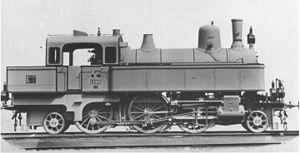kkStB 229
| SB 229 / kkStB 229 / EWA IIIa BBÖ 229 / ČSD 354.0 / FS 912 / JDŽ 116 / PKP OKl12 / MÁV 343 ÖBB 75 / ČSD 354.05 |
|
|---|---|
|
kkStB 229.15
|
|
| Numbering: | kkStB 129.01-17 kkStB 229.01-239 kkStB 229401-417 SB 229.1201-1211 EWA IIIa 41-50 BBÖ 229.04-239 (with gaps) BBÖ 229403-413 (with gaps) BBÖ 229501-511 BBÖ 229801-810 CSD 354001-0145 FS 912.001–005 JDŽ 116-01–25 PKP OKl12-1–22 MÁV 343,301–315 ÖBB 75.701–764 (without 75.760) ČSD 354.0501–0504, 0506 |
| Number: | kkStB 129: 17 kkStB 229: 239 kkStB 229.4: 17 (conversion from 129) SB: 11 EWA: 10 BBÖ 229: 69 (from kkStB) BBÖ 229.4: 5 (from kkStB) BBÖ 229.5: 11 (from SB) BBÖ 229.8: 10 (from EWA) ČSD: 145 (from kkStB) FS: 5 (from kkStB) JDŽ: 25 (from kkStB) PKP: 22 (from kkStB) MÁV: 15 (from ČSD) ÖBB: 63 ČSD 354.05: 5 (from BBÖ ) |
| Manufacturer: | Wr. Neustadt , Floridsdorf , StEG , BMMF , Krauss / Linz |
| Year of construction (s): | 1904-1918 |
| Retirement: | ÖBB: 1962 ČSD: 1967 |
| Type : | 1'C1 'n2vt |
| Gauge : | 1435 mm ( standard gauge ) |
| Length over buffers: | 11,766 mm |
| Height: | 4,568 mm |
| Fixed wheelbase: | 4,000 mm |
| Total wheelbase: | 8,000 mm |
| Empty mass: | 50.2 t |
| Service mass: | 67.1 t |
| Friction mass: | 38.0 t |
| Top speed: | 80 km / h |
| Driving wheel diameter: | 1,614 mm |
| Impeller diameter front: | 870 mm |
| Rear wheel diameter: | 870 mm |
| Number of cylinders: | 2 |
| HD cylinder diameter: | 420 mm |
| LP cylinder diameter: | 650 mm |
| Piston stroke: | 720 mm |
| Boiler overpressure: | 14 bar |
| Number of heating pipes: | 200 |
| Grate area: | 2.00 m² |
| Radiant heating surface: | 9.40 m² |
| Tubular heating surface: | 87.00 m² |
| Water supply: | 9.8 m³ |
| Fuel supply: | 3.1 tons of coal |
The steam locomotive series kkStB 229 was a passenger train - tank locomotive series of the kk Austrian State Railways (kkStB).
history
To improve local passenger traffic, the kkStB procured 1'C-n2v tank locomotives , which were supposed to replace the double-coupled tender locomotives used for this purpose . The tank locomotives also had the advantage that they did not have to be turned at the end points. During the construction, Karl Gölsdorf paid particular attention to good acceleration. The 17 machines in this series, designated 129 , were supplied by the Floridsdorf locomotive factory and the Wiener Neustädter Lokomotivfabrik .
Since the class 129 locomotives were quite successful, the Südbahn wanted to procure similar machines, but with larger stocks. Gölsdorf therefore modified the design by adding a trailing axle. From 1903 to 1907, Floridsdorf delivered eleven of these locomotives, known as the 229 series , to the Südbahn. The kkStB had 239 units built between 1904 and 1918, with all Austrian locomotive factories involved. The machines in series 129 were converted to 1'C1 'and redrawn as series 229.4 . In 1913, the Bohemian-Moravian Machine Works delivered four 229s to the Serbian State Railways and the Wiener Neustädter Lokomotivfabrik produced ten of them for the Vienna-Aspang Railway (EWA) in 1909 and 1920 , which they named EWA IIIa No. 41-50 designated. At times, machines of the 229 series also helped out on the Vienna Stadtbahn .
After the First World War , 69 units remained with the Austrian Federal Railways (then BBÖ), to which eleven units were added as 229.5 and the ten machines of the EWA as 229.8 after the nationalization of the Southern Railway . The Polish State Railways (PKP) received 22 as the OKl12 series , the railways of the Kingdom of Serbs, Croats and Slovenes (SHS) received 25 as the later series JDŽ 116 and the Italian State Railways (FS) received five as FS 912 . The majority of the machines (145 pieces) came to the Czech State Railways (ČSD) after 1918 , which classified them as series 354.0 . When southern Slovakia was ceded to Hungary in 1939 , 15 units came to the Hungarian State Railways (MÁV) as the 343.3 series .
From 1926 to 1934, the ČSD converted five of their 354.0s into superheated steam twin locomotives , which they designated as 355.0 . These machines received a second dome and a connecting pipe between the domes. In another five units, the rear axle was replaced by a bogie between 1936 and 1940; these machines were given the designation 353.1 . In 1944 another machine was converted to superheated steam, in which the second steam dome was not used.
After Austria was " annexed " to the German Reich in 1938, the 90 229s were redrawn by the Deutsche Reichsbahn (DR) as 75,701–790 . In the course of the fighting, the ČSD 355.0 came as 75.901–905, 21 PKP Okl12s as 75.851–871 and nine JD 116 116s as 75.791–799 also to the DR. After 1945, 63 units were classified as class 75 on the Austrian Federal Railways . The last machines in this series were retired in 1962.
The former 229.137, 178, 187, 405 and 115 came to ČSD as 354.0501–0504 and 0506. The 354.0 were in use at ČSD until 1967.
Some former 229ers came to the JDŽ and the PKP.
literature
- Heribert Schröpfer: Locomotives for Austrian railways - steam locomotives BBÖ and ÖBB . alba, Düsseldorf 1989, ISBN 3-87094-110-3 .
- Dieter Zoubek: Preserved steam locomotives in and from Austria . Self-published, 2004, ISBN 3-200-00174-7 .
- Johann Blieberger, Josef Pospichal: The kkStB traction vehicles, Volume 2: Rows 29 to 760 . bahnmedien.at, 2009, ISBN 978-3-9502648-4-5 .



